|
The Meta Bride 1983
|
A black bride painted on white tulle curtain was the centerpiece of this exhibition, which closed on Easter Sunday with a live performance in the gallery.
|
|
(click images for larger view) 
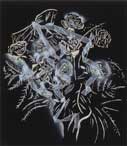 |
Santa Shoshanah, 1982
55” x 48” ink, rubber, lace, wood |
|
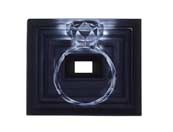 |
Master Frame, 1982
33” x 37”
enamel, wood frames, velvet, glass
private collection |
|
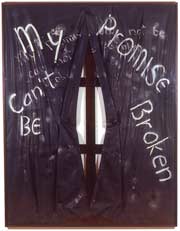 |
Gloomy Gallery, 1983
80” x 62” ink, neoprene, stained wood, magnets, plexiglass
curtains open and close with magnets through the plexiglass frame |
|
|
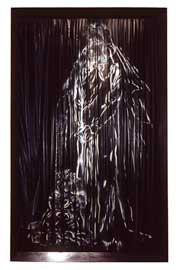 |
Pleated, 1983
124” x 96” enamel, framed pleated neoprene |
|
|
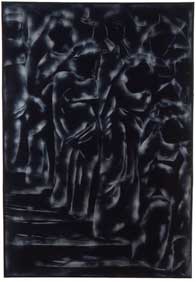 |
The Staircase, 1983
103” x 72” enamel on rubber door mats |
|
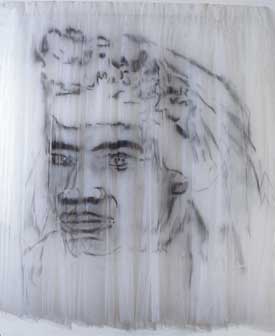 |
The Meta Bride (She’s Flesh and Blood Just Like Her Man), 1982
9’ x 8’
enamel, pleated illusion (tulle)
collection: Whitney Museum of American Art, New York |
|
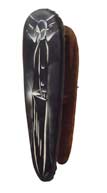 |
Tie & Knot, 1982
37” x 11” x 9”
ink, rubber, ironing board
private collection |
|
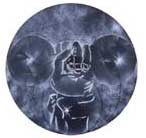 |
Take The Cake, 1982
18” diam.
ink, rubber, plywood |
|
|
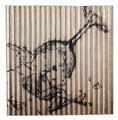 |
Temple Memorex, 1982
26” x 27”
enamel, corrugated plastic, silver leaf
private collection |
|
|
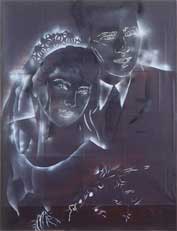 |
My Parents ‘53, 1983
80” x 62”
enamel, undeveloped b/w photo paper
collection of the artist |
|
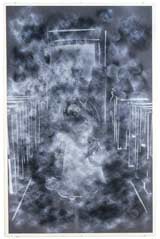 |
Bridemaid’s Dream, 1982
74” x 48”
enamel, chrome coated paper, plywood, tulle |
|
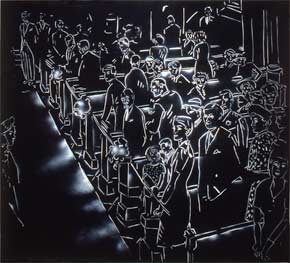 |
The Aisle, 1983
102” x 113”
enamel, chrome coated paper
private collection |
|
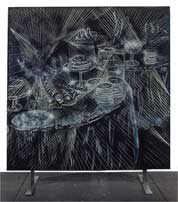 |
A Mile of Screen, 1982
66” x 60”
enamel, rubberized canvas, string, metal
private collection |
|
|
|
| Cast and Credits: |
|
| ULA |
bride,contortion |
| DAVID McDERMOTT |
groom,vocals |
| JEFF BRUNER |
conductor, arrangement |
| NANCY REED |
orchestra coordinator |
| KRISTIAN HOFFMAN |
music, lyrics “I DO” |
| JOHN SOLOMON |
video director |
| THORBJORN HANSSON |
video D. P. |
| JESSICA STACHBURY |
caterer |
| SUSAN MARTIN |
public relations |
| DIANE PERNET |
bridal gown |
| SALLY BEERS |
rubber tuxedo, bouquet |
| JOHN PATRICK |
top hat |
|
|
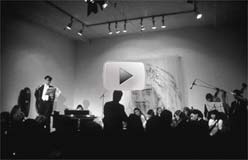 |
| (click image to play video) |
|
|
PROGRAM
“THE MESSAGE”
Grand Master Flash (anachronized by McDermott)
“QUEEN OF THE HIGHWAY”
Morrison/Krieger
“MEMORIES ARE MADE OF THIS”
Gilkyson/Dehr/Miller
“DO RIGHT WOMAN, DO RIGHT MAN”
Penn/Moman
“I DO”
Hoffman |
|
|
The Meta Bride
By Edit DeAk
Italian Vogue Sep. 1983
Our photographer is all business as she strives to snipe celebrities in her viewfinder. In the old days it was simply a matter of nerves and elbows to get close to the star. But the paparazzi needs the eye of a fly to catch who’s who at an event like Izhar Patkin’s “Marriage of White Trash and Black Rap,” a musical accompanied by high tea for invited guests at Holly Solomon’s gallery. So many strata of creative life mingle at Izhar’s Easter parading. There are the hardcore artworld celebrities like me and my boss Ingrid Sischy of ARTFORUM and the painter types, like Julian Schnabel and Ross Bleckner, rising stars of the new esthetic, who in the last two years have vaulted to sensational heights of international media attention and wealth. A clot of Broadway producers, friends of Holly the former actress, are consuming champagne. The intelligensia of the music industry like nightclub mogul Jim Fouratt, nibble cucumber and salmon sandwiches (prepared by Jessica Statchbury, Francesco Clemente’s private English Cordon Bleu chef) while chatting with producers, composers and filmmakers from the cultural guano of the Lower East Side—Kristian Hoffman, who composed the record pressed for this occasion, and New Cinema producers Eric Mitchell and James Nares. High level cruising, new looks and business talk, absorb the fashion starlets like designer Miguel Osuna in hi9s Easter whites, who dressed me in a black cashmere dress, open on top, with neck –to-wrist bone buttons; and of course Sally Beers and Diane Pernet, who designed the thematic, very modern costumes for the wedding performance.
Sally Beers, noted for her exquisite formal leather suits for women, did the Groom, matching the stiff formal fall of the tuxedo with dewey, almost iridescent undulations of rubber. The elegance and peculiarity of this garment, even isolated from the occasion, would express almost everything which this ceremony was about. The rhetoric of Diane Pernet’s look is post-modernist Bauhaus, a stern geometry highly camouflaged with boudoir girlyness—textures, laces, offbeat hairdos, hats and accessories. The Bride, performed by Ula, a blonde all in white leather and Callé lace, was like a negative mirage of Diane, who almost always wears black.
The Gallery is hung with Izhar’s artwork, an exhibition of white-stenciled images on black rubber, icons and symbols of marriage: the ring, the shattered glass, the knife which cuts the cake, the wedding procession of 1200 Moonie couples, the feast and a giant photo-stencil of Devorah and Arie Patkin (parents) on their wedding day, 1953. And as a centerpiece – a portrait of a romanticized black bride.
For this afternoon, the exhibition becomes the setting for a musical, an oratorio simulating a wedding. Neither ridicule from a sophisticated campy stance, nor political propagation of a corrupted social norm, it is a genre play. Izhar, going through the motions of this festivity, throws himself a wedding party spectacle, mixing thematic elements about marriage in a pan-cultural synthesis of the ritual of fusion through the marriage ceremony.
As an impresario, Izhar has a yen to get things done and he can function in a highly competitive metropolitan environment. Producing this kind of spectacle brings his two- and three-dimensional work into the fourth dimension of theatricality. He is making a spectacle in the tradition of painter’s theater. The high formality, the correct attire and demeanor of his elegant guests, the orchestra playing in front of the paintings recall the performances of Yves Klein in the 1960 exhibition of “Anthropometry.”
What Izhar is doing is energizing an underground New York scene in its latency, much as Warhol did in the sixties, turning his camera on those extraordinary individuals who invented transvestite theater. These personages, who at one point collaborated on films and theater, soon fell prey to their highly-strung bohemian temperaments. Warhol, observing these free-floating ready-mades with nothing to do but go to parties, made them underground superstars through a film style that merged documentary and fictive pretexts.
The New York new wave scene is a conglomeration of talents which has ramified into fashion, music, nightclubs, cinema and television, literature and media, and painting. Commercial and boutique culture has recently been exploiting features of the new wave. Just as new wave film directors looked at mass cultural Hollywood models, so too are the gig-budget commercial directors looking at the life styles and heroes of the late seventies underground culture fore exploitation films in the rebellious youth mode.
Meanwhile, the scene which went out into the music and club world to be exploited is pulling back into the artworld, which has a tradition of tolerance, protection of artistic criteria, and right now high media visibility and money because of the painters. The artworld can dish out solid pedigrees; they are experts in the commodity of true vanguard quality, a high value chip in the commercial scheme of things.
David McDermott, the singing star of this affair, is a flashback, an overly estheticized high society dandy. A cherubically joyous personality, he glides on the Icarus wings of an elaborate and genteel protocol. Of anybody from this downtown cultural outburst, it is David who has the most commercially plausible talent. His acting and characterizations in the numerous films and stage shows he has starred in range from a demented Artaudian Caligula to a music hall host.
In the wedding he sang “I Do,” a song especially composed for the occasion, and Grandmaster Flash’s “The Message,” turning the asphalt jungle beat of that inner city doomsday rap into a melodic Gershwin falsetto. The incongruous transposition of the ghetto sound of the eighties into the salon style of the twenties sublimated the song as David’s melodies accentuated the horrific content of the words.
|
Press Release, By Susan Martin:
A Marriage of Music and art at Holly Solomon
In conjunction with his one person show at the Holly Solomon Gallery (March 23 – April 13), artist Izhar Patkin will present a “marriage of white trash and black rap” – a musical accompanied by High Tea for invited guests at the Holly Solomon Gallery, Easter Sunday, April 3rd. Featured will be noted actor-artist and film star, David McDermott as “The Groom,” and America’s premiere female contortionist, Ula, as “The Bride” with a 15 piece orchestra conducted and arranged by Jeff Bruner.
Using Marriage as a metaphor for the artistic liaison of classicism and romanticism uniting both the work on exhibition in the gallery and the concert, the centerpiece of the afternoon’s repertoire will be the original song, “I Do” – a rap trap rhapsody about the marriage of a Black and a White composed by Kristian Hoffman. Attired in a n iridescent grey rubber tuxedo designed by Sally Beers, McDermott croons to his bride, “People say they can’t relate, Don’t you want to integrate?”
Other songs on the afternoon’s program will be Grandmaster Flash’s The Message interpreted in the manner of Gershwin; Queen of the Highway by the Doors; Memories are made of this from “Veronica Voss”; and the culminating Do Right Woman with Ula, the bride and the object of desire, literally transforming herself into a cubist still-life.
The bridal gown of white suede, satin and lace was created by Diane Pernet whose designs have been described by Ben Brantley of WWD as an incongruous pairing of Bauhaus and Charles James. The millinery, a rubber top hat and the Bride’s veil, are by Patrick Fleming, and the guests will dine on tea sandwiches prepared by Jessica Statchbury.
A record of “I Do” (edition of 1,000) with a hand-stenciled portrait of the Bride will be on sale at the Gallery. The artist gratefully acknowledges the support of the Dannheisser Foundation and Holly and Horace Solomon.
|
|
|
|
| |
|